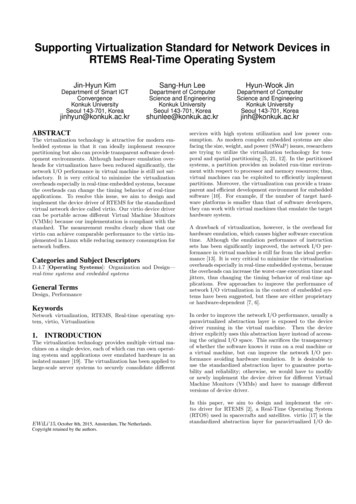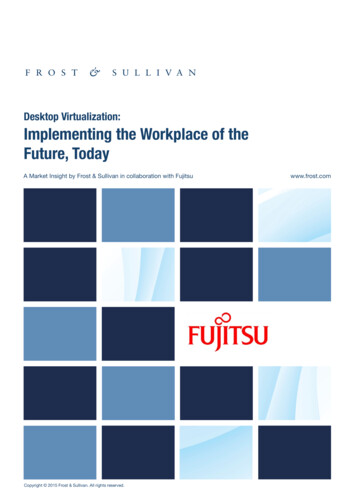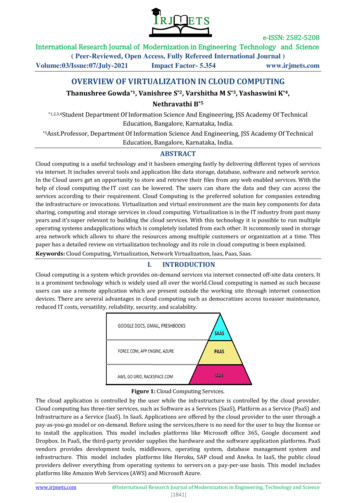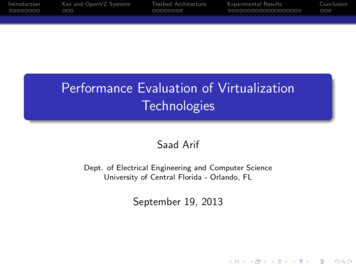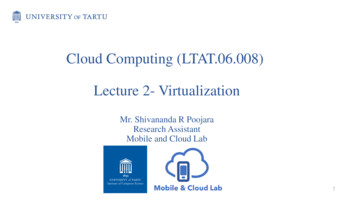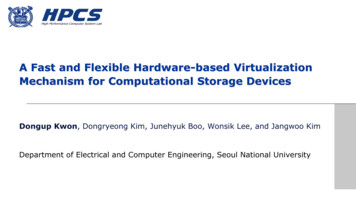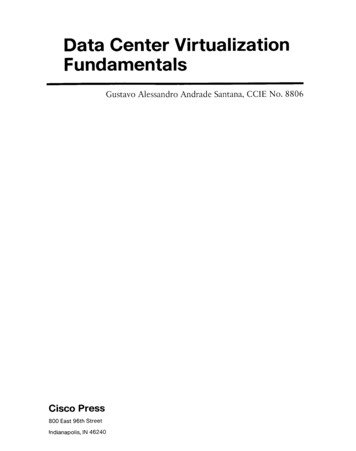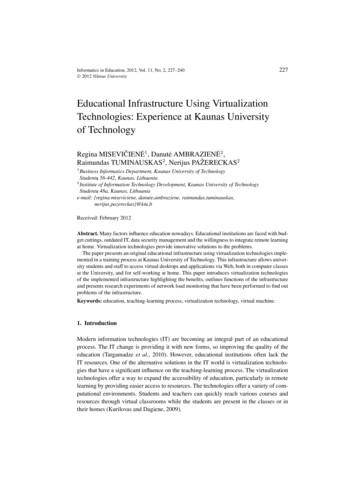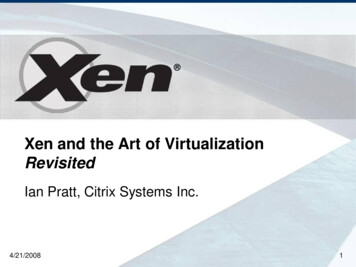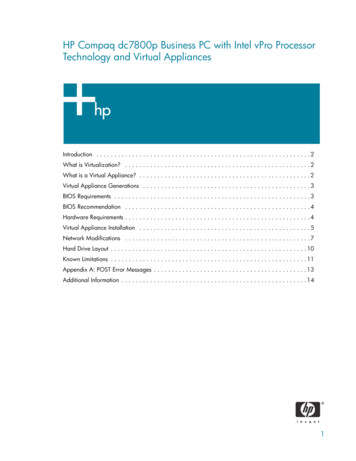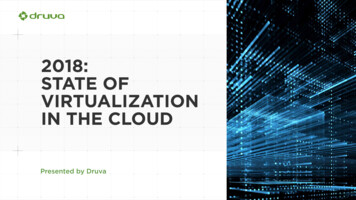
Transcription
2018:STATE OFVIRTUALIZATIONIN THE CLOUDPresented by Druva
Table of Contents3 2018 State of Virtualization in the Cloud4 Trends: Moving Virtual Workloads to the Cloud8 Motivations13 Challenges18 Methodology & Demographics19 About
2018State ofVirtualizationin the CloudDespite this trend, the journey to move virtualworkloads to the cloud isn’t without challenges. Forexample, nearly ¾ of respondents are over reliant onprocesses prone to error, or operating with uncertaintyabout status of their data - and that creates risk andhurts efficiencies. This lack of management andvisibility into workload storage and usage helps toexplain why more than half of respondents (53%) haveyet to achieve cost reduction from using the Cloud.That said, the motivations behind the cloud journeyaren’t entirely cost-driven. In fact, only 1 in 5 stated thatThe momentum of cloud adoption continues to grow for virtualizedworkloads. This year’s survey showed that 41% of respondents arenow running virtual machines (VMs) in the cloud, up from 31% only ayear ago. Furthermore, 90% of respondents are currently running, orcost was the most significant reason to move to thecloud. “Ease of management” and the cloud as “part ofa critical IT initiative,” both topped the list of significantdrivers this year.plan to run, VMs in the cloud in this year, indicating a strong trendNo matter where you fall on your journey to the cloud,towards moving virtual workloads to the cloud. The majority ofone thing is clear: understanding the role the cloudrespondents (59%) plan to leverage AWS for these workloads, withplays with your virtual environments has become an25% of those planning to use VMware Cloud (VMC) on AWS.integral part of IT initiatives, and the momentum isonly growing.2018: State of Virtualization in the Cloud3
Trends:Moving Virtual Workloadsto the CloudKey TakeawayThe growth in respondents running VMs in thecloud year-over-year shows clear momentumbehind this trend. While the lion’s share ofworkloads will be hosted on AWS, a moregranular view shows that respondents will berelying on both, AWS and VMware Cloud (VMC)on AWS to run these workloads.2018: State of Virtualization in the Cloud41%90%59%of organizations currentlyrunning VMs in the cloud,up from 31% in 2017.of respondents are running, orhave plans to run, VMsin the cloud in 2018.of these organizationsare planning to use AWSfor these workloads.4
What is your preferredcloud platform forvirtual workloads?2%4%Google CloudIBM SoftlayerNOTE :34% of respondents prefer usingnative AWS for virtual workloads,and 25% prefer VMware Cloud(VMC) on AWS.35%Microsoft Azure59%Amazon Web Services2018: State of Virtualization in the Cloud5
Do you have VMs running in the cloud now, and if not, how soondo you plan to?20172018Currently running31.4%41%Next three months14.7%7%By the end of 201811.7%11%Sometime in 201932.5%32%9.7%9%Never2018: State of Virtualization in the Cloud6
Are you taking a hybrid cloud approach, with some of yourVMware infrastructure remaining on-premises and some migratingto the cloud?Yes20172018NoLikely butnot sure02018: State of Virtualization in the Cloud0.10.20.30.40.57
Motivations26%of respondents name “ease ofmanagement” as one of the mostimportant drivers of this transition85%see a need for a disaster recoverysolution for the cloudKey TakeawayWhile 20% of respondents still see costs amajor motivator for moving the cloud, “easeof management” and having the move as“part of a critical IT initiative” took priority.Furthermore, over 60% of respondents listedDisaster Recovery as one of the toptechnology reasons driving this transition.Only 1 in 5see cost as a major driver ofthe move to the cloud2018: State of Virtualization in the Cloud8
What is the most important reason drivingyour move to the cloud?20172018Ease of Management16.7%26%Part of a Critical IT Initiative22.1%25%Less Expensive15/6%19%Apps in the Cloud10.4%12%Compliance12.6%6%More Secure13.5%4%Other2018: State of Virtualization in the Cloud8%9
What are the top technology reasons for driving your transitionto the cloud?Disaster RecoveryWorkload MobilityArchival AutomationDeploying StandardApplicationsVirtual DesktopsNoneOther0%2018: State of Virtualization in the Cloud20%40%60%80%10
16% NoDo you see a need for adisaster recovery solutionfor cloud workloads?NOTE :54% of respondents see a needfor DR for cloud workloads,with 31% agreeing that there islikely a need.84% Yes2018: State of Virtualization in the Cloud
Do you plan to have a single, central solution that will protectthe data in your multi-cloud or hybrid cloud environment?Yes20172018NoLikely butnot sure02018: State of Virtualization in the Cloud0.20.40.612
Challenges73%of respondents are over-reliant onprocesses prone to error, or areoperating with uncertainty about thestatus of their data.Key TakeawayA large portion of organizations are puttingthemselves at risk due to a reliance on scriptedorchestration (19%), or having no visibility into how/ifdata management policies are being applied andenforced (54%).In addition, 55% of organizations don’t have a plan tocentralize protection of their data across multi-cloudor hybrid cloud environments. When combined withlack of automated data management, these silosresult in a critical gap in visibility into data.2018: State of Virtualization in the CloudThis leads to increased costs— and helps to explain why of53% organizations have yet to achievelower costs by using the cloud.55%of organizations do not have a plan tocentralize protection of their data acrossmulti-cloud or hybrid cloud environments,ultimately resulting in data silos.13
Is the orchestration of yourAWS workloads automatedor scripted?72% Scripted or UncertainNOTE :19% of respondents are using scriptedorchestration, with 54% uncertain howorchestration is occurring.28% Automated2018: State of Virtualization in the Cloud14
Have you achieved cost reductionby moving to the cloud?NoYes0%2018: State of Virtualization in the Cloud25%50%75%15
As you migrate VMware workloads to the cloud, are you considering re-architectingthem for the cloud or operating them in VMC (VMware Cloud on AWS)?29%Not Sure31%Mix of Both2018: State of Virtualization in the Cloud20%Migrating to Cloud20%Staying in VMware16
Are you also responsible for managing and protecting non-serverdata, like SaaS applications?Yes20172018NoLikely butnot sure02018: State of Virtualization in the Cloud0.250.50.7517
Methodology & DemographicsThe 2018 State of Virtualization and the Cloud survey was produced by Druva, Inc.The survey is a continuation of the Druva 2017 VMware Cloud Migration Survey,and the results were generated through e-mail outreach to IT and virtualizationprofessionals from Druva’s list.A total of 170 responses were collected from around the world, from July 2018 toAugust 2018.2018: State of Virtualization in the Cloud18
Thank you to all the respondents ofthis survey for making it possible!About DruvaDruva’s industry-leading data management-as-as service platform unifies data protection, governance and intelligence acrossenterprise data, delivering enterprise-level scalability and security, while reducing cost and complexity. Over 4,000 enterprises trustDruva to protect and manage more than 100PB of data worldwide. Visit Druva and follow us @druvainc.2018: State of Virtualization in the Cloud19
2018: State of Virtualization in the Cloud 18 Methodology & Demographics The 2018 State of Virtualization and the Cloud survey was produced by Druva, Inc. The survey is a continuation of the Druva 2017 VMware Cloud Migration Survey, and the results were generated through e-mail outreach to IT and virtualization professionals from Druva's list.
